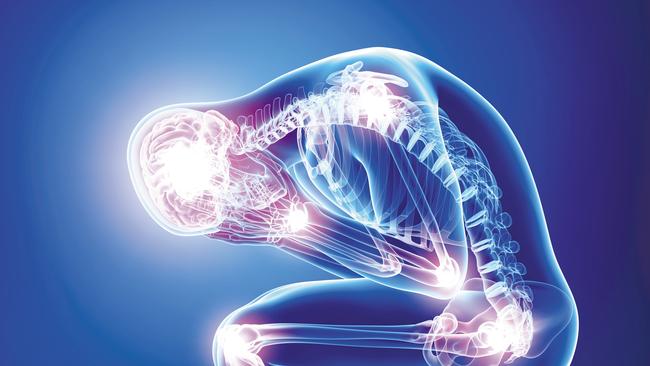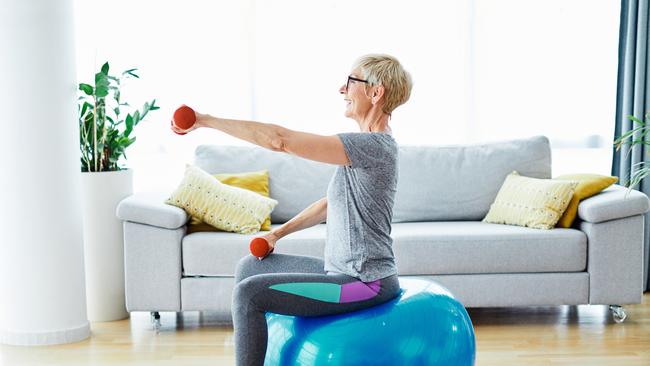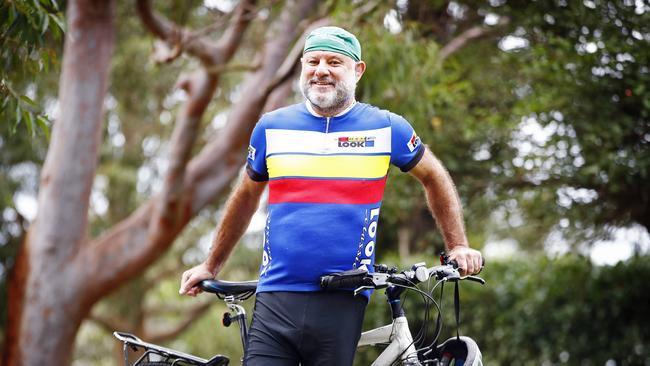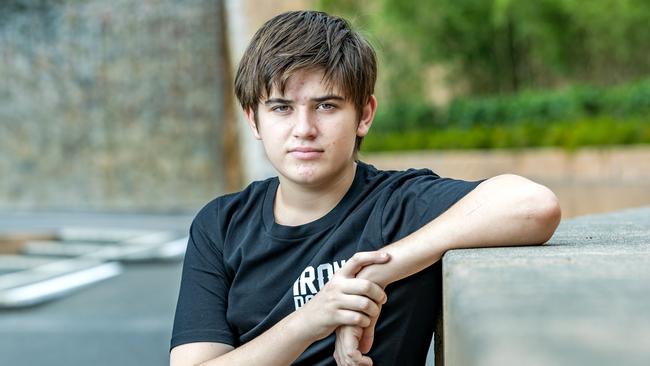Australians face arthritis and osteoarthritis: Best ways to beat pain
Four in ten Australians will develop arthritis in their lifetime and there are things that will help the most to relieve their pain.
National
Don't miss out on the headlines from National. Followed categories will be added to My News.
Exclusive: Millions of Australians with osteoarthritis are getting substandard care that can actually make their condition worse.
The best treatment for osteoarthritis is not a pill or even surgery — it’s weight loss and exercise.
University of Sydney Professor David Hunter said Australians with the condition would get twice as much pain relief by losing weight and exercising than they would from any pill but too few patients are ever told to do it.
A key reason is Medicare does not fund help with diet and exercise — only medication and surgery, with five subsidised allied health care visits per year.
Professor Hunter said a proper program required at least 10 to 12 visits to a physiotherapist, dietitian, psychologist and exercise physiologist.
“Different studies have suggested that referral rates to a surgeon are about 10 times what they would be to a physiotherapist so patients are not being provided a vehicle or a venue to get the core treatments,” he said.

Osteoarthritis costs the health care system in excess of $4 billion a year with half that spent on surgery.
If we could prevent the need for surgery — which in 20 per cent of cases does not improve the outcome for patients — the savings would be mammoth.
More than half of patients with osteoarthritis do not receive appropriate care for their condition, as recommended by current guidelines.
As SUE DUNLEVY reports, there are positive actions we can take to turn things around.

MEDICATION PITFALLS
Most people who visit a doctor for help with osteoarthritis will be prescribed an anti-inflammatory pill or paracetamol. One in five will be prescribed an opioid.
But these medications can have serious side effects and opioids can actually be dangerous and lead to worsening of pain if used long term.
University of Sydney’s Dr Christina Abdel-Shaheed, who conducted a major review of pain relief medication, found paracetamol did provide help for osteoarthritis of the hip and knee but only reduced pain by three per cent compared to a dummy pill.
Prof. Hunter said anti-inflammatory drugs like ibuprofen, Diclofenac, Celecoxib probably provide about 25 per cent relief from osteoarthritis pain.
However, these medications — especially when used in older people — carry a high risk of gastrointestinal bleeding, stomach ulcers, stroke or heart attack, liver and kidney problems.
Studies show opioids cut the pain of osteoarthritis by only four per cent compared to a dummy pill and when used for longer than 12 days can lead to dependence that makes the pain worse, Dr Abdel-Shaheed said.
“It might not actually be the pain condition that’s worsening, but it’s their dependency to the opioid medicine where they feel like they need to take a higher dose to be able to get the pain relief they used to but they also experience heightened sensation to pain,” she said.
WEIGHT LOSS
Weight loss is better than drugs at reducing the pain caused by arthritis, with every kilo lost estimated to remove around 3.5 kilos of pressure off the knees.
“Losing 10 per cent of your body weight improves (osteoarthritis) symptoms by 50 per cent,” said Professor Hunter.
Despite these impressive pain relief outcomes, multiple studies have found just 17 of every 100 GP visits by patients with hip and knee osteoarthritis saw weight loss or exercise prescribed.
Patient surveys have found only 50 per cent of people with osteoarthritis were trying to lose weight.
But the results are clear.
One in six patients with knee osteoarthritis and four per cent of people with hip osteoarthritis
no longer needed surgery, after participating in a large NSW osteoarthritis trial integrating physical therapy, dietary advice and pain relief.

EXERCISE
Strengthening exercises and increased physical activity can deliver a 30 to 40 per cent reduction in pain for people with osteoarthritis.
A physiotherapist or exercise physiologist can provide personally tailored exercises to strengthen the muscles that cross the joint that’s affected by arthritis.
Strength work is required three to four times per week and general physical activity needs to be increased to 150 minutes per week.
“That’s exercising to a point where you’re puffing and may you find it hard to maintain a conversation,” Professor Hunter said.
Cycling, swimming, walking, other aquatic sports like kayaking are good if high impact exercise like tennis and running hurt the joints.
Yoga, Tai Chi, pilates, dancing and flexibility exercises that include muscles stretches are also recommended.
Patient surveys have found just 18 per cent or people with osteoarthritis were engaged in a muscle strengthening program.

KNEE REPLACEMENT
Knee replacements to treat osteoarthritis have surged by more than a third in recent decades but as many as one in four are performed outside clinical guidelines.
A quarter of patients who have a hip replacement and nearly half those who have a knee replacement are unsatisfied or continue to experience pain after the surgery.
Surgical outcomes are worst in obese patients.
Only one in four patients have tried exercise or weight loss before being placed on surgery waitlists even though such strategies could eliminate the need.
“Joint replacement should be reserved for people in the latter stages of the disease. That’s not what’s happening. And that’s a not a good use of health resources because it carries with it substantial risk,” said Professor Hunter.
Around 30,000 Australians a year get a knee replacement and it is costing the health system $100 million.
DANGER OF SPORTS INJURIES
Sporting injuries can lead to arthritis in later life — especially knee injuries.
Ruptures of the anterior cruciate ligament, which supports the knee, is linked to osteoarthritis changes in 50 to 70 per cent of patients, a decade on.
One in four cases of knee osteoarthritis in men and 14 per cent in women could be prevented — if that person had not been injured in the first place.
The sports most frequently linked to knee injuries are Australian rules, rugby union, rugby league, netball, basketball, soccer, and skiing.
Warm-up exercises, strength and agility training, done for 15 to 20 minutes two to three times per week, can reduce the risk of osteoarthritis in people who play sport.

NON MEDICATED PAIN RELIEF
Drugs are not the only way to relieve the pain caused by arthritis
*try a warm bath, heat pack or hot water bottle over the painful area for 15 minutes.
*apply ice packs. Cold numbs the painful area and reduces swelling
*massage
*A TENS machine uses electric pulses to block pain messages going to the brain
*Relaxation techniques, such as deep breathing, guided imagery (mental pictures) and progressive muscle relaxation, can help you reduce stress and muscle tension.
‘I BELIEVE IN THE POWER OF THE MIND’
Psychologist Tom Buttel developed osteoarthritis from a rugby injury in his teens and managed to avoid a knee replacement by losing seven kilos and exercising.
The 62 year old hurt his knee playing rugby for St Joseph’s College in Sydney’s Hunter’s Hill and had surgery at age 17 and an arthroscopy at age 29.
“I’ve lived with osteoarthritis for 40 years and been told its stage four, so it can’t get much worse than that, there’s no stage five,” he said.
A knee replacement was recommended at age 50 but he avoided the knife after undertaking a special arthritis program at Hunter’s Hill Private hospital.

The program included help from a rheumatologist, a physiotherapist, a dietitian, and an exercise physiologist, who gave him specially-tailored exercises.
It involved exercise machines and bicycles, weight bearing exercises, modified squats and hydrotherapy in the pool.
“There was an occupational therapist there that told me the correct way to get in and out of the car and out of bed and even get on and off the toilet so that you’re not putting excess stress on the joint,” he said.
“I walk every day for about two hours. I get out of bed at 4.30 and I’m out and walking at five.
“I’ve never really been a person to take painkillers or any inflammatories because I believe in the power of the mind and that’s where the mindfulness and the meditation comes in.
“At the moment, I don’t need a knee replacement.”
‘WE COULD REALLY USE MORE SUPPORT’
Nathan Faucett developed juvenile arthritis as a toddler and even though he was often screaming with pain and unable to move he was not diagnosed until he was seven.
Now 15, the teen and his family have suffered from the high cost of managing the condition and dreadful side effects from limited treatment options.
“His knees double in size and it has also gone to his feet, fingers, wrist, spine. It’s very hard on him psychologically he’s in constant pain,” his mother Kathleen Faucett said.
Nathan has been unable to access high cost biologic treatments because he lives in a regional area and he had to cease methotrexate treatment after his weight dropped to 32 kilos when he suffered severe side effects.
Now he is reliant on opioids and paracetamol to control the pain.
But an NDIS package that funds an exercise physiologist, physiotherapist and an occupational therapist has helped him manage the condition.

Juvenile arthritis is an inflammatory auto-immune condition that can seriously affect the growth and development of a child, causing severe joint damage, growth abnormalities and permanent disability if not diagnosed and treated early.
Patient support group Arthritis Australia is calling for greater help from Medicare to cover the crippling out of pocket medical expenses of families with juvenile arthritis.
“Families are telling us that they need more affordable access to the allied health services such as physiotherapy that their kids need. Five appointments per year through the Medicare Chronic Disease Management Plans just isn’t enough,” said Louise Hardy, Arthritis Australia’s National Policy and Government Relations Manager.
Faucett said sometimes Nathan waited more than six weeks for treatment.
“That means sometimes withdrawing Nathan from school because his symptoms are too severe,” she said.
“We could really use more support.
“Before we got an NDIS package, we had to pay for lots of medical appointments, not to mention the costs of medicines and parking.”





